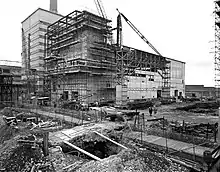B205
B205 is the name of the Magnox nuclear reprocessing plant at Sellafield in northern England. This plant uses PUREX chemistry (based on tributyl phosphate (TBP)) to extract plutonium and uranium from used nuclear fuel.[1] The plant was originally constructed and operated by the United Kingdom Atomic Energy Authority (UKAEA), but in 1971 control was transferred to British Nuclear Fuels Limited (BNFL).

B205 was commissioned in 1964 as a replacement for the UK's first nuclear reprocessing plant, B204, which was converted into a pre-handling plant for B205 and recommissioned in 1969. In 1973, after both plants had been shut down for one year for repairs, a violent reaction in the B204 plant occurred which contaminated the entire plant and 34 workers with ruthenium-106. Following this event the B204 plant was permanently decommissioned.[2] There is evidence that a similar ruthenium oxidation and sublimation reaction may have occurred in 2017 in the Mayak reprocessing facility in southern Russia, however both the facility and the Russian government deny this.[3][4][5]
Over its lifetime, the B205 plant has handled over 35,000 tons of expended Magnox fuel, and returned over 15,000 tons of uranium to the fuel cycle. Now that the Magnox reactors have been retired from use, the final fuels are being processed, and the B205 plant is slated for decommissioning around 2020 after all fuel has been reprocessed.[6][7]
Process
The process uses mixer settlers as the basis of the plant operation. The unit comprises a set of mixing compartments where the solvent and aqueous liquids mix. The mix then passes to an associated settler compartment where the solvent separates from the aqueous and forms 2 separate layers. These then leave the settler compartment to the next mixer compartments. The solvent and aqueous flow in opposite directions through the mixer settler stages (typically 8 or more), controlled by careful design of the transfer ports between the settler stages.
The Magnox fuel is dissolved in nitric acid within the Dissolver Cell. The aqueous stream is conditioned to the correct temperature and acidity and then passes to the first mixer settler system where fission products are separated from the uranium (U) and plutonium (Pu) by extraction of the U/Pu into the solvent phase comprising tri-butyl-phosphate in odourless kerosene. This has the effect of reducing the radiation levels in subsequent stages of the process and the resulting degradation of the solvents.
The solvent stream of U, Pu and remaining fission products then passes to the critical mixer settler stages where the U and Pu are transferred into the aqueous phase and fission products remain in the aqueous phase. Separation of the U and Pu is achieved by adding a reductant, which causes the Pu, but not the U, to transfer into the solvent phase. Once separated, further removal of fission products is undertaken by more mixer settler units.
The U and Pu streams are then passed to evaporators to concentrate the U and Pu before further processing in other plants.
See also
References
- Berkhout, Frans (1997). "The International Civilian Reprocessing Business" (PDF). Energy and Security. Institute for Energy and Environmental Research. Retrieved 10 May 2015.
- "Reprocessing plant B204". Archived from the original on November 24, 2005. Retrieved January 7, 2006.
- Detection of Ruthenium 106 in France and in Europe: Results of IRSN’s investigations
- Radioactive cloud that covered Europe might be from Russia
- Russia starts cleaning up Cold War-era nuclear waste 2017. "from Andreyeva Bay, the spent fuel will be shipped on board a specially-equipped vessel to Russia's Arctic port of Murmansk, then on to its final destination, the Mayak nuclear reprocessing plant in Chelyabinsk, near the Ural Mountains."
- "Magnox Reprocessing Plant (B205)". Archived from the original on November 28, 2005. Retrieved March 29, 2006.
- Leafe, Martin (24 January 2017). "Cleaning up our nuclear past: faster, safer and sooner". Nuclear Decommissioning Authority. Retrieved 14 September 2019.